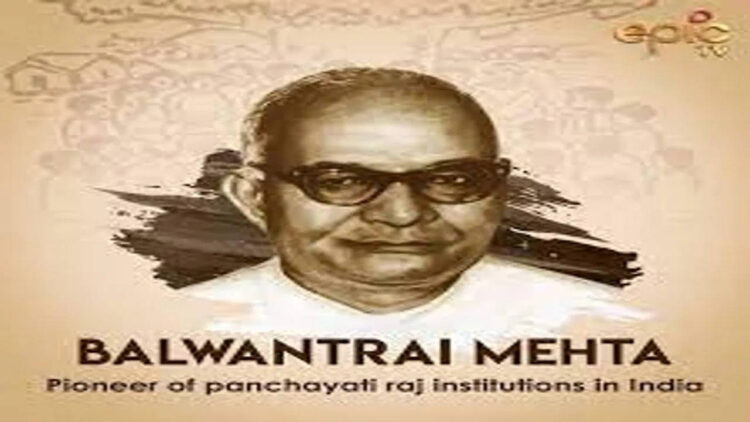Balwantrai Gopalji Mehta (English: Balwantrai Gopalji Mehta, born- 19 February 1900; death- 19 September 1965) was an Indian politician and second Chief Minister of Gujarat. He also participated in the Indian independence movement. He is considered the architect of Panchayati Raj for his contribution towards democratic decentralization.
Birth and education
Balwantrai Mehta was born on 19 February 1900 in a medium class family in Bhavnagar. He has a B.A. Had studied till His graduation was completed in 1920. When the results came, he was passed in every subject. He refused to take the degree given by the British government. At this time he was just 20 years old. After leaving the college, Lala took membership of Lajpatarai’s organization ‘Sarvent of Peepal’. The ‘Servant of India’ was a non-political organization. Lala ji formed this organization for social service other than Congress. Balwantrai Mehta was its member for a long time and its president was also elected twice.
Political start
1921 was the year when Balwantrai Mehta’s political journey started. In 1921, he founded the ‘Bhavnagar Prajamandal’. At that time Bhavnagar used to be a Princely State or Rajwada. There was no direct possession of the British here. Guhil used to rule the king Krishnakumar Singh. At the age of just 21, Balwantrai had started taking a front against feudal rule. In 1928, Satyagraha started under the leadership of Gandhiji and Sardar Patel in Bardoli, Surat. Balvantrai emerged as an important member of this Satyagraha. He remained in jail during the non -cooperation movement, which lasted from 1930 to 1932. He was again imprisoned during the 1942 Quit India Movement. He remained in jail for about seven years before independence.[1]
After independence, at the behest of Gandhiji, Balwantrai Mehta took membership of the Congress Executive. Elections were held for the first time in the country in 1952. Bhavnagar was known as Gohilwad because of Gohil kings at that time. Balwantrai contested from here on a Congress ticket. He was competed, Independent candidate Krishnalal. Balwantrai Mehta became an honorable MP by securing 80256 votes. There were second Lok Sabha elections in 1957. Balwantrai contested from Gohilwad (Bhavnagar). Jashwant Bhai Mehta of Praja Socialist Party was in front. Balwantrai won the election easily by securing 82582 votes. At the same time, Jashwant Bhai Mehta was able to get only 62958 votes.
Panchayati Raj’s grandfather
Gandhiji had drawn the blueprint of ‘Swaraj’, in which every village had to work like a free independent unit. He wanted every village to be so self -sufficient that his government could run himself. Therefore, it was necessary to strengthen every village and village panchayat. After the second Lok Sabha elections in 1957, Pandit Jawaharlal Nehru took initiative in this direction. In fact, in January of 1957, a committee was formed to investigate community development programs. Balwantrai Mehta was presiding over this committee. In November 1957, the committee submitted its recommendations. The entire blueprint of the three -level Panchayati Raj was kept in front.
On 1 April 1958, Parliament passed and implemented the ‘Balwant Rai Mehta Samiti’ safaris. On 2 October 1959, Pandit Nehru duly started the Panchayati Raj in India from Nagaur district of Rajasthan. But Andhra Pradesh became the first state to fully implement these recommendations. Panchayati Raj institutions in India had to wait a long time to achieve constitutional status. In 1993, the 73rd amendment was given constitutional status to Panchayati Raj. Their regular elections were ensured, but there was no change in the structure of the three -tier Panchayati Raj suggested by the Balwantrai Mehta Committee. These are the three levels- Gram Panchayat at the village level, Panchayat Samiti at the block level and District Panchayat at the district level. In this way, the structure given by Balwantrai Mehta continues unintentional even today.[1]
Chief Minister’s post
The Kamaraj Plan, which came on 24 August 1963, sacrificed several strong leaders of the Congress. Uttar Pradesh Chief Minister Chandrabhanu Gupta used to come from Nehru’s anti -camp. As part of the Kamaraj plan, Pandit Nehru resigned from Chandrabhanu Gupta in August 1963. Morarji Desai was very against this resignation. He first tried to convince Nehru ji. When Nehru did not agree, he was adamant on the resignation of Jeevraj Mehta under this plan. Gujarat was the home of Morarji. Jeevraj Mehta became the first Chief Minister of the state due to Nehru ji’s recommendation against Morarji’s will. Jeevraj Mehta had to resign from his post due to the pressure of Morarji. Morarji had earlier suggested Balwantrai Mehta’s name, but could not run much in front of Nehru. On this occasion, he reached the chair of the Chief Minister of Gujarat to the man of his choice. Balwantrai Mehta became the second Chief Minister of the state on September 1963.
Death
On September 19, 1965, Balwantrai Mehta was going from Mithapur to Kutch during the Indo-Pak war. On the way, his aircraft was attacked by the Pakistani Air Force, in which his wife, three activists, a journalist and two aircraft were killed along with Mehta ji.









